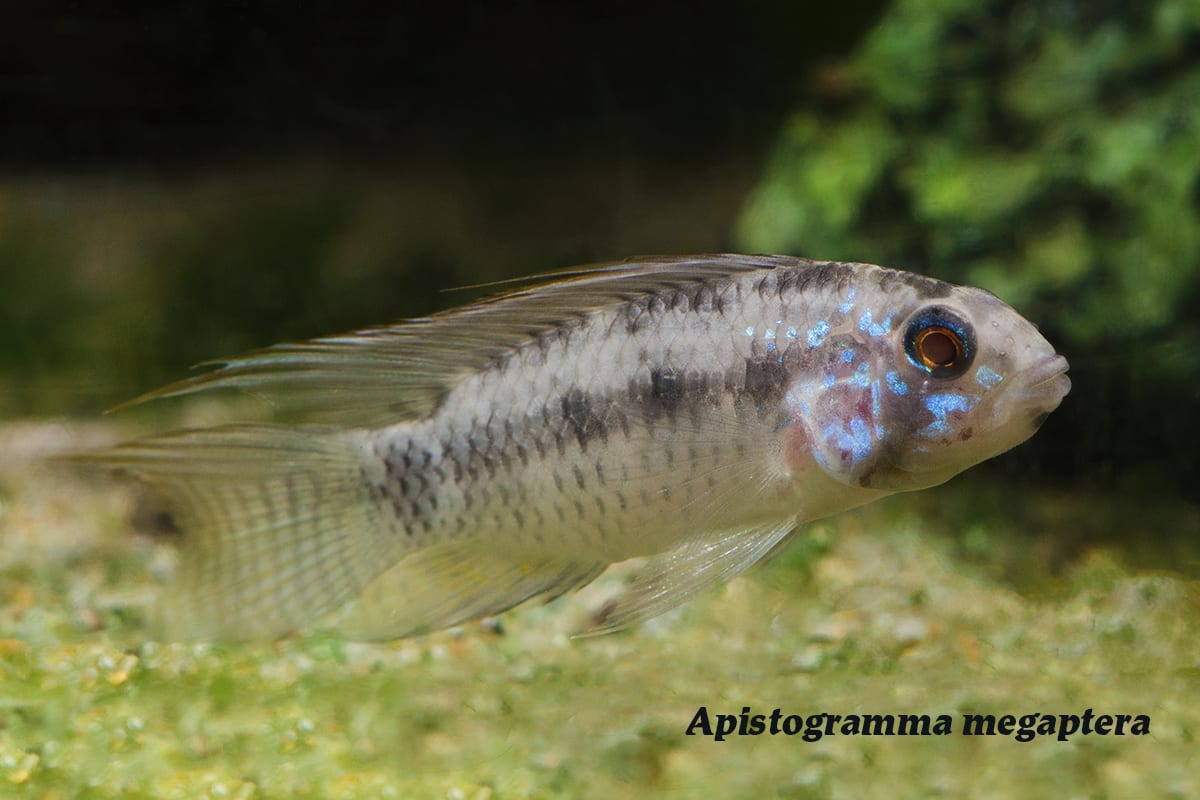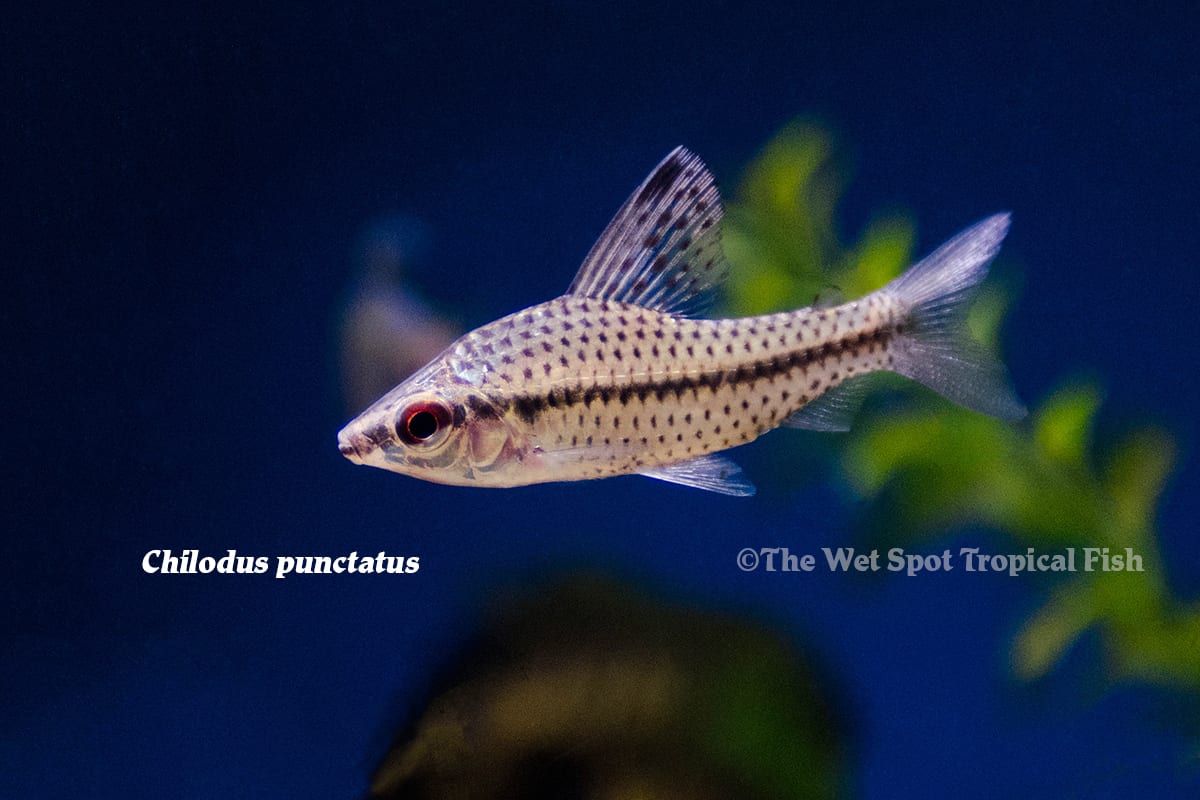Happy Tanks-giving
Happy Tanks-giving!
Gratitude (noun):
The quality of being thankful; readiness to show appreciation for and return kindness.
We have a lot to be thankful for here at The Wet Spot. Most of all, you, the amazing fish-loving community we are surrounded by every day. This dedicated and passionate group never ceases to inspire us to be the best tropical fish purveyors we can be. In an effort to turn that kindness “on its head”, this week we’ll focus on a few house favorites that will open up the warm “circle” of the holiday season’s “long-winged” embrace. Hark!: Planiloricaria cryptodon, Apistogramma megaptera, and Chilodus punctatus.
Scientific NamePlaniloricaria cryptodon
Common NameCircular Whiptail Catfish
Temperature / pH72 to 80°F / 6.0 to 7.0 pH
Native LocationAmazon basin
Preferred DietAufwuchs and small invertebrates
“Whipping” through the sandy bottoms of main streams in the Amazon basin, P. cryptodon is so unique it is the only member of its genus. Known as the “Circular Whiptail”, this catfish reaches 8.5 inches in length and has a flattened, circular head with handlebar-like whiskers, a long and spiny sail-like dorsal fin, and a long thin whip for a tail. Bottom-dwellers by nature, they prefer biotope setups with soft, sandy substrate, scattered dried leaves, water-worn rockwork, twisted branches and driftwood, and filtered lighting through tall or floating plants. A peaceful catfish, they can be kept in tanks with small South American characins, Apistos, and other quiet loracariids that aren’t to vigorous bottom competitors. Generally omnivorous, they feed on aufwuchs and small invertebrates in the wild. In captivity they do best with diets comprised of live and frozen fare, high-quality, sinking dried foods, and fresh vegetables like blanched spinach or zucchini. Tank waters are best maintained with temperatures of 72 to 80°F, pH between 6.0 and 7.0, and hardness around 35 to 178 ppm.
Scientific NameApistogramma megaptera
Common NameN/A
Temperature / pH72 to 82°F / 4.0 to 6.5 pH
Native LocationOrinoco basin
Preferred DietSmall invertebrates
A rare, and just recently described Apisto, A. megaptera is truly a collector’s dwarf cichlid. “Megaptera” translating roughly to “long-winged”, these apistos have beautiful, long, trailing fins edged with bright red and black. Males reach about 2.75 inches in length, and exhibit a red hugh with a dark horizontal stripe down their sides, a black cheek stripe, shiny blue scales on their faces, and a light purple tone on their underbellies. Females reach about 2 inches, and have more plain coloration with tones of yellow on their faces and underbellies. Found primarily in the upper Orinoco basin, these apistos prefer slow-moving tributaries, creeks and backwater habitats with fallen leaves. For tank setup, think: cover! They require lots of hiding places like overturned ceramic pots, length of pvc pipe, dense vegetation, rockwork, and roots and branches. Filtration need not be any stronger than an air-powered sponge setup. Ideal for community tanks, they do best alongside small “dither” fish like peaceful South American characins, and calm, peaceful bottom-dwelling loricariids. Primarily carnivores in the wild, they should be fed mostly live and frozen foods to show their best coloration, though they will accept high-quality dried foods as well. Tank waters should be kept with temperatures between 72 and 82°F, pH around 4.0 to 6.5, and hardness of 18 to 90 ppm.
Scientific NameChilodus punctatus
Common NameSpotted Headstander
Temperature / pH70 to 80°F / 5.0 to 7.5 pH
Native LocationAmazon system
Preferred DietOmnivorous
Found throughout the Amazon system of Ecuador and Peru, C. punctatusprefers slow-moving rivers and floodplain lakes to do its acrobatics. Known as the “Spotted Headstander”, this characid is characterized by how they float with their bodies slanted, noses angled downward, and caudal fins to the sky! Reaching just over 3 inches in length, these circus performers have pointed faces and narrow bodies covered in dark spots with a long horizontal stripe, and red fins. In captivity they do best in tanks equipped with sandy substrate, driftwood roots and tangles, leaf litter, and floating vegetation like duckweed and water lettuce. They can be kept with submerged vegetation with thick, hardy leaves (soft leaves get nibbled) as well. Shy and peaceful by nature, they should be kept with slow-moving tank mates like calm tetras, small loricariids, and peaceful dwarf cichlids like apistos or mikrogeophagus. Generalist omnivores by nature, they should be fed balanced diets of high-quality dried foods, live and frozen invertebrates, and fresh vegetables. They do best in waters with temperatures around 70 to 80°F, pH of 5.0 to 7.5, and hardness between 18 and 179 ppm.
What more to be thankful for than a tank full o’ these guys eh? Allow us to show you our gratitude by helping you achieve the pinnacle of your personal aquarium best! Happy Tanks-giving everyone!


